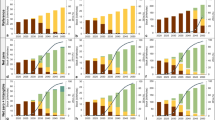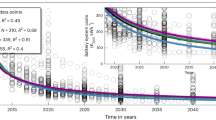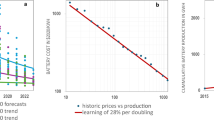Abstract
The electrification of trucks is a major challenge in achieving zero-emission transportation. Here we gathered year-long records from 61,598 electric trucks in China. Current electric trucks were found to be significantly underutilized compared with their diesel counterparts. Twenty-three per cent of electric delivery trucks and 30% of semi-trailers could achieve one-on-one replacement with diesel counterparts, while on average 3.8 electric delivery trucks and 3.6 electric semi-trailers are required to match the transportation demand that is served by one diesel truck separately. For diesel trucks that are capable of one-on-one replacement, electric trucks have 15–54% and 1–49% reductions in cost and life-cycle CO2 emissions, respectively. Enhancements in usage patterns, vehicle technologies and charging infrastructure can improve electrification feasibility, yielding cost and decarbonization benefits. Increased battery energy densities with optimized usage can make one-on-one electrification feasible for more than 85% of diesel semi-trailers. In addition, with cleaner electricity, most Chinese electric trucks in 2030 will have lower expected life-cycle CO2 emissions than diesel trucks.
This is a preview of subscription content, access via your institution
Access options
Access Nature and 54 other Nature Portfolio journals
Get Nature+, our best-value online-access subscription
$32.99 / 30 days
cancel any time
Subscribe to this journal
Receive 12 digital issues and online access to articles
$119.00 per year
only $9.92 per issue
Buy this article
- Purchase on SpringerLink
- Instant access to full article PDF
Prices may be subject to local taxes which are calculated during checkout




Similar content being viewed by others
Data availability
Material CO2 emission factors in China, life-cycle CO2 emission data and TCO results are available via Figshare at https://doi.org/10.6084/m9.figshare.24421210 (ref. 46). More specific datasets or materials are available from S.Z. or Y.W. upon reasonable request. Source data are provided with this paper.
Code availability
The codes that support the findings of this study are available from the corresponding authors upon reasonable request.
References
Global Energy-Related CO2 Emissions by Sector (International Energy Agency, 2020); https://www.iea.org/data-and-statistics/charts/global-energy-related-co2-emissions-by-sector
Basma, H. & Rodríguez, F. Race to Zero: How Manufacturers are Positioned for Zero-Emission Commercial Trucks and Buses in Europe (International Council on Clean Transportation (ICCT), 2021); https://theicct.org/publication/race-to-zero-ze-hdv-eu-dec21/
Advanced Clean Fleets Regulation Summary (California Air Resources Board, 2023); https://ww2.arb.ca.gov/resources/fact-sheets/advanced-clean-fleets-regulation-overview
Memorandum of Understanding on Zero-Emission Medium- and Heavy-Duty Vehicles (Transport Decarbonisation Alliance, 2023); https://globaldrivetozero.org/site/wp-content/uploads/2023/08/Global-MOU-Signatories-2023.pdf
Proposal for a Regulation of the European Parliament and of the Council amending Regulation (EU) 2019/1242 as regards strengthening the CO2 emission performance standards for new heavy-duty vehicles and integrating reporting obligations, and repealing Regulation (EU) 2018/956 Document 52023PC0088 (European Commission, 2023); https://eur-lex.europa.eu/legal-content/EN/TXT/?uri=CELEX%3A52023PC0088
Energy-Saving and New Energy Vehicle Technology Roadmap 2.0 (China Society of Automotive Engineers, 2021)
Global EV Data Explorer (International Energy Agency, 2023); https://www.iea.org/data-and-statistics/data-tools/global-ev-data-explorer
Wappelhorst, S. & Rodríguez, F. Global overview of government targets for phasing out internal combustion engine medium and heavy trucks. ICCT Blog https://theicct.org/global-overview-of-government-targets-for-phasing-out-internal-combustion-engine-medium-and-heavy-trucks/ (2021)
Nykvist, B. & Olsson, O. The feasibility of heavy battery electric trucks. Joule 5, 901–913 (2021).
Mao, S., Basma, H., Ragon, P.-L., Zhou, Y. & Rodríguez, F. Total Cost of Ownership for Heavy Trucks in China Battery Electric Fuel Cell and Diesel Trucks White Paper (ICCT, 2021); https://theicct.org/publication/total-cost-of-ownership-for-heavy-trucks-in-china-battery-electric-fuel-cell-and-diesel-trucks/
Forrest, K., Mac Kinnon, M., Tarroja, B. & Samuelsen, S. Estimating the technical feasibility of fuel cell and battery electric vehicles for the medium and heavy duty sectors in California. Appl. Energy 276, 115439 (2020).
Liimatainen, H., Van Vliet, O. & Aplyn, D. The potential of electric trucks – an international commodity-level analysis. Appl. Energy 236, 804–814 (2019).
Hao, H. et al. Impact of transport electrification on critical metal sustainability with a focus on the heavy-duty segment. Nat. Commun. 10, 5398 (2019).
Borlaug, B. et al. Heavy-duty truck electrification and the impacts of depot charging on electricity distribution systems. Nat. Energy 6, 673–682 (2021).
McCall, M. & Phadke, A. A. California Semi Truck Electrification: Preliminary Assessment of Infrastructure Needs and Cost-Benefit Analysis (Lawrence Berkeley National Laboratory, 2019)
Lanz, L., Noll, B., Schmidt, T. S. & Steffen, B. Comparing the levelized cost of electric vehicle charging options in Europe. Nat. Commun. 13, 5277 (2022).
Wang, K., Zavaleta, V. G., Li, Y., Sarathy, S. M. & Abdul-Manan, A. F. N. Life-cycle CO2 mitigation of China’s class-8 heavy-duty trucks requires hybrid strategies. One Earth 5, 709–723 (2022).
Wang, Q., Miller, M. & Fulton, L. Technology and Fuel Transition: Pathways to Low Greenhouse Gas Futures for Cars and Trucks in the United States (Univ. California, Davis, 2023)
Sacchi, R., Bauer, C. & Cox, B. L. Does size matter? The influence of size, load factor, range autonomy, and application type on the life-cycle assessment of current and future medium- and heavy-duty vehicles. Environ. Sci. Technol. 55, 5224–5235 (2021).
Liang, X. et al. Air quality and health benefits from fleet electrification in China. Nat. Sustain. 2, 962–971 (2019).
Wang, G., Fulton, L. & Miller, M. The Current and Future Performance and Costs of Battery Electric Trucks: Review of Key Studies and A Detailed Comparison of Their Cost Modeling Scope and Coverage (Univ. California, Davis, 2022); https://doi.org/10.7922/G2D50K9T
Burke, A., Miller, M., Sinha, A. & Fulton, L. Evaluation of the Economics of Battery-Electric and Fuel Cell Trucks and Buses: Methods, Issues, and Results (Univ. California, Davis, 2022); https://escholarship.org/uc/item/1g89p8dn
Kurani, K. S., Miller, M., Sugihara, C., Stepnitz, E.-A. & Nesbitt, K. A. Determinants of Medium- and Heavy-Duty Truck Fleet Turnover (Univ. California, Davis, 2023); https://escholarship.org/uc/item/20n8n4mb
Hunter, C. et al. Spatial and Temporal Analysis of the Total Cost of Ownership for Class 8 Tractors and Class 4 Parcel Delivery Trucks (National Renewable Energy Laboratory, 2021); https://www.nrel.gov/docs/fy21osti/71796.pdf
Burnham, A. et al. Comprehensive Total Cost of Ownership Quantification for Vehicles with Different Size Classes and Powertrains (Argonne National Laboratory, 2021); https://publications.anl.gov/anlpubs/2021/05/167399.pdf
Mao, S. & Rodríguez, F. Race to Zero: How Manufacturers are Positioned for Zero-Emission Commercial Trucks and Buses in China (ICCT, 2021); https://theicct.org/publication/race-to-zero-how-manufacturers-are-positioned-for-zero-emission-commercial-trucks-and-buses-in-china/
MacDonnell, O. et al. Zero-Emission Truck and Bus Market Update (CALSTART, 2022); https://globaldrivetozero.org/site/wp-content/uploads/2022/10/ZE_TruckBus_update.pdf
Mao, S., Zhang, Y., Rodríguez, F., Wang, S. & Hao, C. Real-World Performance of Battery Electric Heavy-Duty Vehicles in China: Energy Consumption, Range, and Charging Patterns (ICCT, 2023); https://theicct.org/publication/hdv-china-real-world-performance-apr23/
Cui, H., Xie, Y. & Niu, T. China is propelling its electric truck market by embracing battery swapping. ICCT Blog https://theicct.org/china-is-propelling-its-electric-truck-market-aug23/ (2023)
Wang, F. et al. Multisectoral drivers of decarbonizing battery electric vehicles in China. PNAS Nexus 2, pgad123 (2023).
Herberz, M., Hahnel, U. J. J. & Brosch, T. Counteracting electric vehicle range concern with a scalable behavioural intervention. Nat. Energy 7, 503–510 (2022).
Wei, W., Ramakrishnan, S., Needell, Z. A. & Trancik, J. E. Personal vehicle electrification and charging solutions for high-energy days. Nat. Energy 6, 105–114 (2021).
Wang, Z. Annual Report on the Big Data of New Energy Vehicle in China (2021) (Springer, 2023)
Yin, Q., Shuhan, S. & McLane, R. The Actual Performance of Zero-Emission Trucks in the United States and Europe and its Implications for China (in Chinese) (CALSTART, 2022); https://globaldrivetozero.org/site/wp-content/uploads/2022/05/EFC-Task-2_CH.pdf
Nykvist, B., Sprei, F. & Nilsson, M. Assessing the progress toward lower priced long range battery electric vehicles. Energy Policy 124, 144–155 (2019).
Total cost of ownership estimator. California Hybrid and Zero-Emission Truck and Bus Voucher Incentive Project (HVIP) https://californiahvip.org/tco/ (2023)
How to Buy an Electric Truck: Public Funding Helps Hauliers to Deliver on Zero Emission Road Freight (Transport & Environment, 2022); https://www.transportenvironment.org/articles/how-to-buy-an-electric-truck
Run on Less – Electric Depot program (North American Council for Freight Efficiency, 2023); https://runonless.com/
Limits and Measurement Methods for Emissions from Diesel Fuelled Heavy-Duty Vehicles (China VI) (Ministry of Ecology and Environment of the People’s Republic of China, 2018)
Zhang, S. et al. On-board monitoring (OBM) for heavy-duty vehicle emissions in China: regulations, early-stage evaluation and policy recommendations. Sci. Total Environ. 731, 139045 (2020).
Greenhouse Gases, Regulated Emissions, and Energy Use in Transportation (GREET) Model (Argonne National Laboratory, 2023); https://greet.es.anl.gov
He, X. et al. Economic and climate benefits of electric vehicles in China, the United States, and Germany. Environ. Sci. Technol. 53, 11013–11022 (2019).
Fuel Consumption Limits for Heavy-Duty Commercial Vehicles (draft for comment) (Ministry of Industry and Information Technology of the People’s Republic of China, 2022)
Ledna, C., et al. Decarbonizing Medium- & Heavy-Duty On-Road Vehicles: Zero-Emission Vehicles Cost Analysis (National Renewable Energy Laboratory, 2022); https://www.nrel.gov/docs/fy22osti/82081.pdf
Hall, D. & Lutsey, N. Estimating the Infrastructure Needs and Costs for the Launch of Zero-Emission Trucks White Paper (ICCT, 2019); https://theicct.org/publication/estimating-the-infrastructure-needs-and-costs-for-the-launch-of-zero-emission-trucks/
Zhao, P. et al. Challenges and opportunities in truck electrification unveiled by big operational data. Figshare https://doi.org/10.6084/m9.figshare.24421210 (2024)
Acknowledgements
We are grateful to the National Key Research and Development Program of China (Grant No. 2022YFC3703600, Y.W.), the National Natural Science Foundation of China (52170111, S.Z.) and Energy Foundation China (Grant No. G-2310-35151, S.Z.). We thank M. Wang from Argonne National Laboratory for useful discussion. We thank A. Wang and all members from MIT Senseable City Lab for their generous help. We thank the North American Council for Freight Efficiency (NACFE) for the data and visualized results for the Run on Less – Electric Depot program.
Author information
Authors and Affiliations
Contributions
P.Z., S.Z., P.S., C.R., Z.W. and Y.W. designed the research; D.C., P.L., Z.Z., J.L. and Z.W. prepared and pre-processed the data; P.Z., S.Z. and P.S. developed the assessment methods and performed the research; P.Z., S.Z., P.S. and Y.W. analysed the data; P.S., F.W., C.R. and Y.W. provided valuable discussions and edited the manuscript; P.Z., S.Z., P.S., C.R. and Y.W. wrote and revised the paper.
Corresponding authors
Ethics declarations
Competing interests
The authors declare no competing interests.
Peer review
Peer review information
Nature Energy thanks Kelly Fleming, Felipe Rodriguez and the other, anonymous, reviewer(s) for their contribution to the peer review of this work
Additional information
Publisher’s note Springer Nature remains neutral with regard to jurisdictional claims in published maps and institutional affiliations.
Supplementary information
Supplementary Information
Supplementary Figs. 1–15, Tables 1–10 and Notes 1–4.
Source data
Source Data Fig. 1
Data on the daily mileage percentile of DTs and ETs by fleet and the annual trip number percentile of DTs and ETs by fleet.
Source Data Fig. 2
Data on life-cycle CO2 emission results for Fig. 2a and TCO results for Fig. 2b.
Source Data Fig. 3
Replacement rate modelling result under different trip mileages and increased active trips (VKT).
Source Data Fig. 4
CO2 emissions and TCO gaps between DT and ET fleets under different scenarios.
Rights and permissions
Springer Nature or its licensor (e.g. a society or other partner) holds exclusive rights to this article under a publishing agreement with the author(s) or other rightsholder(s); author self-archiving of the accepted manuscript version of this article is solely governed by the terms of such publishing agreement and applicable law.
About this article
Cite this article
Zhao, P., Zhang, S., Santi, P. et al. Challenges and opportunities in truck electrification revealed by big operational data. Nat Energy 9, 1427–1437 (2024). https://doi.org/10.1038/s41560-024-01602-x
Received:
Accepted:
Published:
Issue date:
DOI: https://doi.org/10.1038/s41560-024-01602-x
This article is cited by
-
Gridded mobile source emissions with multiple processes and pollutants from 2011 to 2020 in China
Scientific Data (2025)
-
Environmental burden and health inequity in China’s road-based express delivery
Nature Cities (2025)



